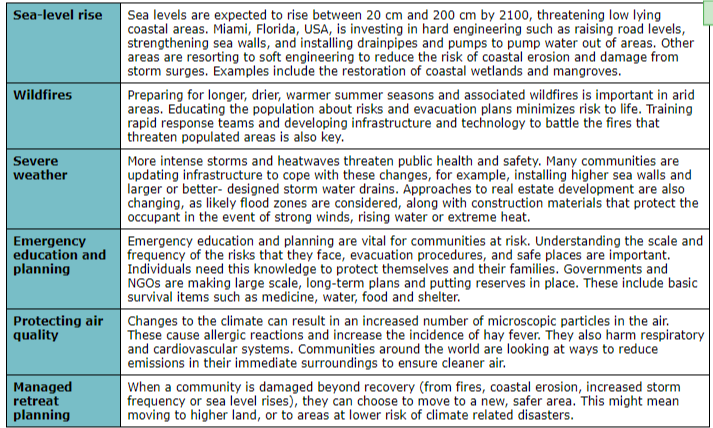Unit 8 - Managing climate change
8.1 Climate change
Greenhouse gases: gases in the atmosphere that absorb infrared radiation
e.g) Water vapour, CO2, CH4
CH4 is 28x more effective at holding heat than CO2
Human sources of greenhouse gases
Combustion of fossil fuels (CO2 + water vapor): releases CO2 underground + into the atmosphere; created water vapor during combustion
Coal is the most polluting fossil fuel
Rice & livestock farming (methane): methane is released when organic material is broken down
Rice farming in flooded fields blocks O2 from getting to the soil, which creates conditions for bacteria decomposing vegetation to release methane
Livestock eat vegetation → break it down & release methane
Deforestation for livestock → adds to CO2 levels
Warming climate → permafrost melts → releases CH4 → causes more permafrost to melt
Landfill gas (methane): by-product of decomposition of organic material found in buried waste → releases CH4 + CO2
Enhanced greenhouse effect
Increased amount of infrared radiation being retained in the atmosphere due to human activities, which increase GHGs in the atmosphere
Difficulties monitoring + predicting climate change
Historical data: relies on limited amount of proxy data — relies on natural records from the environment
Ice cores: drill from deep in the ice; analyse for info on past temperatures, precipitation, volcanic activity etc.
Corals: build skeletons out of calcium carbonate; can determine water temperature at the time the coral grew
Tree rings: can determine climatic conditions at the time of tree growth; composition of rings reflect change in the climate
Historical accounts provide qualitative + quantitative data that can determine climate conditions of the past
Computer climate models: use data on variables, like temperature & precipitation, to predict future climate; wide range of possibilities makes creating models difficult
Climate feedback models: can speed up/slow down factors that drive climate change; difficult to predict the impact of feedback mechanisms on the climate — they aren’t fully understood & can be unreliable
Time delay b/t cause and effect: can take years/decades to see the impact of increases GHGs
Can make computer modeling complicated & uncertain
Data uncertainty: different opinions on future potential changes in the climate within the politics + science
8.2 The impacts of climate change
Environmental impacts
Increase temperatures
Impact frequency + intensity of precipitation
Sea level rise: melting land ice + ice sheets cause more water to enter the oceans
Ocean circulation: disrupt ocean currents → can increase precipitation in N. Atlantic & melt polar ice sheets + glaciers
Melting ice: reduced albedo effect = increased amount of solar energy absorbed, melting of permafrost = increased methane
Species distribution and biodiversity: can alter habitats
Human impacts
Increased frequency + severity of extreme weather, which causes: flooding, strong winds, loss of land + lives
Less precipitation + increases temps = drought + wildfires
Forced migration: natural disasters make certain parts of the world difficult to live in, causing people to migrate
Impacts on crop yields: can decrease due to increased temps + changes in rainfall patterns
Climate change can cause outbreaks of insects, like locusts, which decrease yield
Threatens water + energy security:
Increased evaporation + fluctuating levels of precipitation (e.g. increase can spread disease)
Need to implement renewable energy sources to combat climate change, which can be challenging + cause energy insecurity
8.3 Managing climate change
Reduction of global and individual carbon footprint
Fewer children per woman: lower carbon emissions + energy consumption
Plant-based diet: less CO2 emissions for transport + less CO2 & CH4 emissions by not eating meat
Energy-efficient lifestyle: timers on showers, energy-efficient light bulbs, etc
Low-carbon fuels: lower carbon content than petroleum fuels (e.g. natural gas & biofuel)
Reduce CO2 emissions, BUT increased land use for biofuels (e.g. corn + sugarcane)
Reducing the use of fossil fuels + individual (e.g. public transport) & gov’t (e.g. clean energy policies) actions
Using alternative forms of energy (e.g. wind, solar, geothermal)
Transport policies: need to consider reduction of CO2 emissions + improved fuel efficiency
Catalytic converters, sustainable biofuels (e.g. biogas), & improved public transportation
Use of carbon capture and storage: capturing CO2 before it’s released into the atmosphere & storing it
Pre-combustion: before fossil fuels are burned → fossil fuels into CO2 and hydrogen
Requires significant modification to power plants
Post-combustion: removes CO2 after burning fossil fuels
Oxyfuel technology: burning fossil fuels with nearly pure oxygen, producing CO2 + steam
Technology is expensive & possible CO2 leakage at storage sites
Reducing deforestation: reforestation/afforestation increase tree biomass + carbon stored
Cost-effective + improves water security (increased transpiration & less runoff, which recharges aquifers)
Energy efficient buildings and infrastructure: take advantage of sun’s energy, well-insulated, low-energy consumption features
Passive buildings: eco-friendly; consume low amounts of energy + make use of energy sources in the building
Adaptation to climate change
National and international agreements:
Kyoto Protocol: reduce GHG emissions by acknowledging that global warming exists & human-caused emissions are the underlying cause
Paris Agreement: UN agreement addressing GHG emissions starting in 2020
Geo-engineering / Solar radiation management (SRM)
Reflect some incoming solar radiation & limit the amount of energy trapped by GHGs
Albedo enhancement: large pumps to introduce microbubbles into bodies of standing water & reflective films on top of the ocean surface
Stratospheric aerosols: sulfate aerosols spray aerosol into the atmosphere into the stratosphere by using a tethered balloon, which reflects sunlight
Simple, inexpensive, & technologically feasible, BUT may cause drought/flooding, limited research available, untested, & short-term
Space reflections: reflect incoming solar radiation rays before getting trapped in the atmosphere
